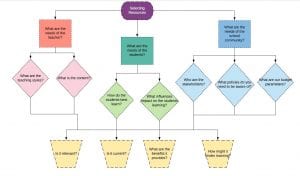How the subject has extended your knowledge and understanding of the role and nature of school library collections.
The original concept of the role of the Teacher Librarian (TL) and their collection was to foster a passion for books, maintain their quality and create a safe environment for students (Bernard, 2019, March 13). Now, the understanding of a TL and their collection is to meet the needs, abilities and interests of all users and incorporate the larger school community. A collection is undertaking continual growth and development to reach and meet the needs of every user, both within the school environment and the wider school community. The role of the collection is to provide active instructional programs that engage students with the curriculum content in a variety of ways. IFLA (2015) present the expansive capabilities that libraries provide for students ranging from resource-based to personal and interpersonal capabilities (p.17) and the active TL is a facilitator to developing the capabilities through collaborative and engaging instruction.
The current focus is on the digital information and locating, critiquing and providing a large range of resources to enable digital learning and engagement with digital learners (Bernard, 2019, March 10). Furthermore, the TL incorporates the role of collaborator to introduce a wide variety of resources and formats both inside the classroom and with the wider school environment, providing support and flexibility in the learning environment (DeCourcy Hinds, 2015). Through collaboration and active involvement with the school community, the TL and the collection develop an understanding of the needs of the users and can future cater to these needs.
The importance of a collection development policy as a strategic document.
A Collection Development Policy was originally seen as a set of guidelines in the process of locating, selecting and acquiring resources (Bernard, 2019, March 12), however, Collection Development expands beyond the process and explores the needs of the students, staff, and wider school community. The CDP is utilised to create broad goals and aims that encompass the ethos of the school and reflects a diverse range of needs. A strong policy is present when the goals ensure that the collection is meeting both the needs of the current users but also the future users (ALIA, 2017). A strong collection and a strong CDP promote opportunities to the school community and provides a sense of direction for the individuals involved. The strength of a CDP comes from the transparency to the school community, with information resources being aligned with the set criteria already provided. A CDP that aligns with the curriculum content, interests, abilities and needs of the users supports the teaching and learning experiences within the school community and curates the collection to promote and engage learning. These clearly stated policies and procedures unite the TL and the wider school community and can be referred to in times of discrepancies. The CDP is used as a reference, protector of the collection (Johnson, 2018) and provides clear direction in the acquisition and de-selection processes rather than decision-making processes of students (Bernard, 2019, March 21).
How a collection development policy assists in future proofing the collection.
The CDP provides clear criteria to thoroughly evaluate and review the collection. Through this analysis and examination of the interaction with the current collection, TL’s shape their understanding and knowledge of the school interests, abilities and needs and curates the collection accordingly. The collection maintains balance, relevance and reliable information. Through the collaboration, support and drive of the wider school community the TL in turn supports the learning and teaching styles present in the school environment. As the ‘library’ becomes an increasingly digitally focused place. Irving (2019, May 17) discusses the importance of reviewing CDP’s to ensure that regarding new digital content students are receiving equal access, alongside a deep understanding of concepts such as Copyright. The incorporation of these concepts will assist the future users to have clear direction in the processes and resources available to them. Furthermore, Murphy (2019, May 12) expands on the question of where to begin when catering the CDP and collection for both current and future students when there is minimal resources to start. The beginning steps in the development of the collection would be crucial to mention in the goals of the CDP.
Overall, the knowledge gained throughout this course is crucial to the work of a future TL. The shift in understanding and expansion of information from simple definitions to full concepts with unique challenges assist in formulating direction and excitement to build upon the school’s collection.
References:
Australian Library and Information Association School & Victorian Catholic Teacher Librarians. (2017). A manual for developing policies and procedures in Australian school library resources centres. (2nd ed.). Retrieved from: https://asla.org.au/resources/Documents/Website%20Documents/Policies/policies-procedures-manual_ed2.pdf
Bernard, P. (2019, March 10). Response To Shatzkin’s Articles [Online Discussion Comment]. Retrieved from Charles Sturt University https://interact2.csu.edu.au/webapps/discussionboard/do/message?action=list_messages&course_id=_42383_1&nav=discussion_board_entry&conf_id=_78886_1&forum_id=_147529_1&message_id=_2160935_1
Bernard, P. (2019, March 12). Definitions of Collection Management and Collection Development [Online Discussion Comment]. Retrieved from Charles Sturt University https://interact2.csu.edu.au/webapps/discussionboard/do/message?action=list_messages&course_id=_42383_1&nav=discussion_board_entry&conf_id=_78886_1&forum_id=_147530_1&message_id=_2169109_1
Bernard, P. (2019, March 13). My Understanding of the Role of TLs [Thinkspace Blog]. Retrieved from https://thinkspace.csu.edu.au/paigespages/2019/03/13/13-3-19-my-understanding-of-the-role-of-tls/
Bernard, P. (2019, March 21). Week 3 503 Post! [Thinkspace Blog]. Retrieved from https://thinkspace.csu.edu.au/paigespages/2019/03/21/21-3-19-week-3-503-post/
DeCourcy Hinds, J. (2015, March 15). Building a Library from Scratch. School Library Journal. Retrieved from https://www.slj.com/?detailStory=how-to-build-a-school-library-from-scratch
International Federation of Library Associations and Institutions. (2015). IFLA school library guidelines. Retrieved from: https://www.ifla.org/files/assets/school-librariesresource-centers/publications/ifla-school-library-guidelines.pdf
Irving, K. (2019, May 17). New Digital Content in the Collection and the resulting Changes in the CDP [Online Discussion Comment]. Retrieved from Charles Sturt University https://interact2.csu.edu.au/webapps/discussionboard/do/message?action=list_messages&course_id=_42383_1&nav=discussion_board_entry&conf_id=_78886_1&forum_id=_147542_1&message_id=_2293813_1
Johnson, P. (2018). Fundamentals of Collection Development and Management 4th Edition. Chicago: ALA Editions. Retrieved from http://search.ebscohost.com.ezproxy.csu.edu.au/login.aspx?direct=true&db=nlebk&AN=1856983&site=ehost-live
Murphy, C. (2019, May 12). Digital areas needing coverage in your collection development policy [Online Discussion Comment]. Retrieved from Charles Sturt University https://interact2.csu.edu.au/webapps/discussionboard/do/message?action=list_messages&course_id=_42383_1&nav=discussion_board_entry&conf_id=_78886_1&forum_id=_147542_1&message_id=_2283038_1
